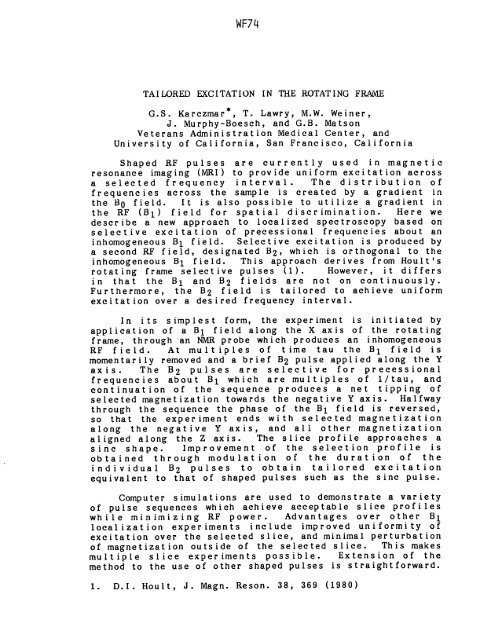th - 1987 - 51st ENC Conference
th - 1987 - 51st ENC Conference
th - 1987 - 51st ENC Conference
You also want an ePaper? Increase the reach of your titles
YUMPU automatically turns print PDFs into web optimized ePapers that Google loves.
WF74<br />
TAILORED EXCITATION IN THE ROTATING FRAME<br />
G.S. Karczmar*, T. Lawry, M.W. Weiner,<br />
J. Murphy-Boesch, and G.B. Matson<br />
Veterans Administration Medical Center, and<br />
University of California, San Francisco, California<br />
Shaped RF pulses are currently used in magnetic<br />
resonance imaging (MRI) to provide uniform excitation across<br />
a selected frequency interval. The distribution of<br />
frequencies across <strong>th</strong>e sample is created by a gradient in<br />
<strong>th</strong>e B 0 field. It is also possible to utilize a gradient in<br />
<strong>th</strong>e RF (B 1) field for spatial discrimination. Here we<br />
describe a new approach to localized spectroscopy based on<br />
selective excitation of precessional frequencies about an<br />
inhomogeneous B 1 field. Selective excitation is produced by<br />
a second RF field, designated B2, which is or<strong>th</strong>ogonal to <strong>th</strong>e<br />
inhomogeneous B 1 field. This approach derives from Hoult's<br />
rotating frame selective pulses (1). However, it differs<br />
in <strong>th</strong>at <strong>th</strong>e B 1 and B 2 fields are not on continuously.<br />
Fur<strong>th</strong>ermore, <strong>th</strong>e B 2 field is tailored to achieve uniform<br />
excitation over a desired frequency interval.<br />
In its simplest form, <strong>th</strong>e experiment is initiated by<br />
application of a B 1 field along <strong>th</strong>e X axis of <strong>th</strong>e rotating<br />
frame, <strong>th</strong>rough an NMR probe which produces an inhomogeneous<br />
RF field. At multiples of time tau <strong>th</strong>e B 1 field is<br />
momentarily removed and a brief B 2 pulse applied along <strong>th</strong>e Y<br />
axis. The B 2 pulses are selective for precessional<br />
frequencies about B 1 which are multiples of 1/tau, and<br />
continuation of <strong>th</strong>e sequence produces a net tipping of<br />
selected magnetization towards <strong>th</strong>e negative Y axis. Halfway<br />
<strong>th</strong>rough <strong>th</strong>e sequence <strong>th</strong>e phase of <strong>th</strong>e B 1 field is reversed,<br />
so <strong>th</strong>at <strong>th</strong>e experiment ends wi<strong>th</strong> selected magnetization<br />
along <strong>th</strong>e negative Y axis, and all o<strong>th</strong>er magnetization<br />
aligned along <strong>th</strong>e Z axis. The slice profile approaches a<br />
sine shape. Improvement of <strong>th</strong>e selection profile is<br />
obtained <strong>th</strong>rough modulation of <strong>th</strong>e duration of <strong>th</strong>e<br />
individual B 2 pulses to obtain tailored excitation<br />
equivalent to <strong>th</strong>at of shaped pulses such as <strong>th</strong>e sine pulse.<br />
Computer simulations are used to demonstrate a variety<br />
of pulse sequences which achieve acceptable slice profiles<br />
while minimizing RF power. Advantages over o<strong>th</strong>er B 1<br />
localization experiments include improved uniformity of<br />
excitation over <strong>th</strong>e selected slice, and minimal perturbation<br />
of magnetization outside of <strong>th</strong>e selected slice. This makes<br />
multiple slice experiments possible. Extension of <strong>th</strong>e<br />
me<strong>th</strong>od to <strong>th</strong>e use of o<strong>th</strong>er shaped pulses is straightforward.<br />
1. D.I. Hoult, J. Magn. Reson. 38, 369 (1980)













